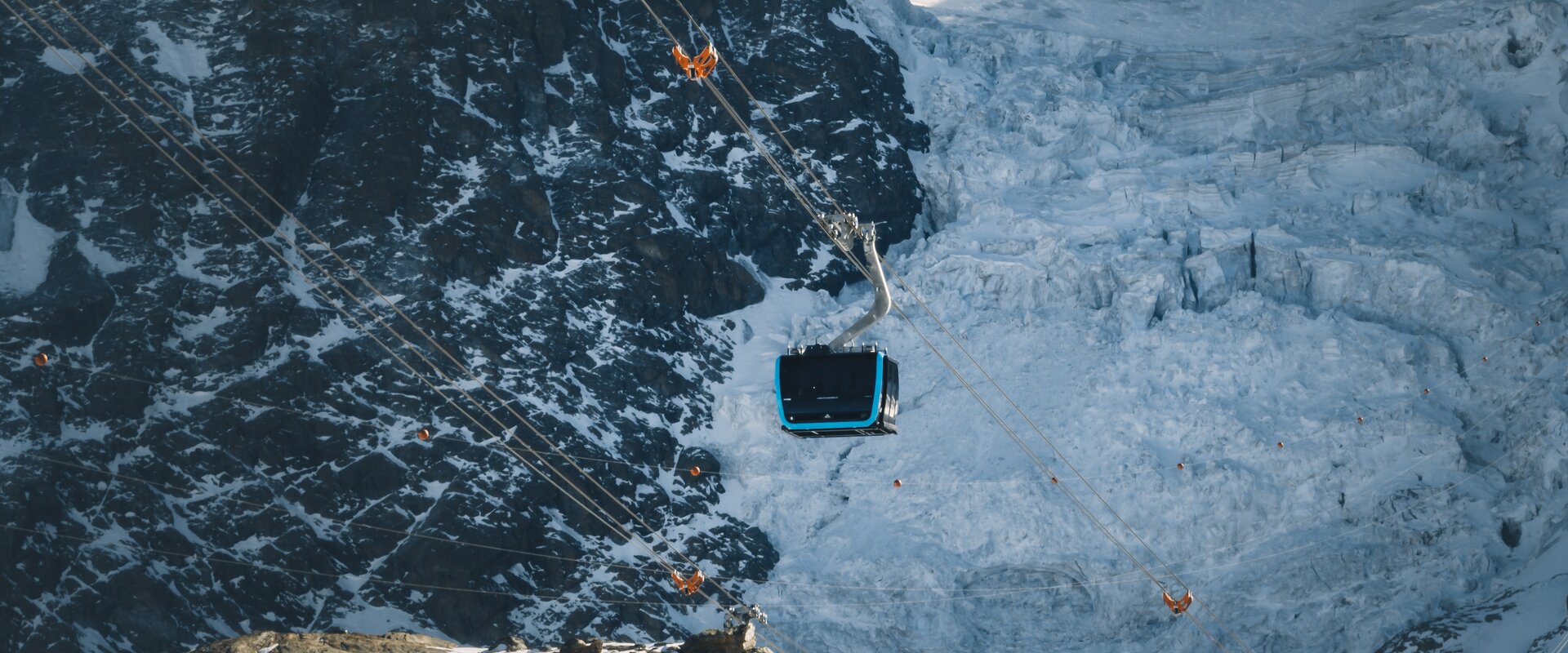



Matterhorn Alpine Crossing
3S cableways and their characteristics
The cableway connection between Switzerland and Italy
The Matterhorn Glacier Ride I has been operating from Trockener Steg to the Matterhorn Glacier Paradise since the 2018/19 winter season. The modern 3S cableway will now be complemented by a new connection between the Matterhorn Glacier Paradise and the Testa Grigia valley station in Italy. This is a momentous development and a pinnacle of technical achievement. 3S cableways bring together the best in technology and design, increasing ride comfort and keeping maintenance to a minimum by extending the service life of the various components.
From 1 July 2023, Zermatt Bergbahnen’s Matterhorn Glacier Ride II will connect the Matterhorn Glacier Paradise at an altitude of 3883 metres above sea level with Testa Grigia in Italy at 3480 metres. Once again, the company behind the construction of the new 1.6 km link is the ropeway manufacturer LEITNER. Five cables will be used to convey ten cabins between the Matterhorn Glacier Paradise mountain station and the valley station at Testa Grigia. Two cables mounted between the stations in both directions of travel function as support cables. The hauling rope is a circulating cable, its ends spliced together to form a continuous loop. It rotates between the two stations, transporting the ten cabins clamped to it. On entering the station, the cabins are released from the hauling cable and moved slowly through the station on a tyre conveyor system before being clamped back onto the hauling cable as they exit.
3S cableways offer a number of advantages over conventional cableways. They ensure a more stable ride in high winds, have a higher carrying capacity and are faster. With a maximum speed of 7.5 metres per second, the Matterhorn Glacier Ride II can transport up to 1300 passengers between the Matterhorn Glacier Paradise and Testa Grigia every hour. The trip takes just four minutes.
The cables – different functions
The hauling cable and the support cables of the 3S cableway were all manufactured by the Swiss company Fatzer AG. The support cables have a smooth surface which allows the cabins to glide over them quietly. The outer layer of the locked-coil spiral rope is made up of wires with a shaped profile that enables them to interlock like a zip fastener. This manufacturing method ensures that the individual profile wires cannot escape from the structure of the cable even if they were to break. The smooth surface of the support cables also protects them from penetration by moisture and dirt. Two of the four support cables are fitted with fibre optic cables, ensuring that a redundant data connection is maintained between the stations. They also allow key data to be constantly monitored, including values relating to the strand anchors for the mountain station and cable tension. They also transmit internet and intranet communications.
The hauling cable consists of twisted strands and is spliced to form a continuous loop. There are eight strands, each of which is made up of 25 individual wires. Unlike the support cable, the surface is not flat but wound around a core in a helix pattern. This method of manufacture makes the hauling cable particularly dynamic and also very resilient under mechanical loads.
The cabins – spacious and modern
The cabins manufactured by Sigma measure 3.7 by 3.6 metres and are 2.2 metres high. There are 28 seats per cabin, making them significantly bigger than those of any other cableway. They have a wide entrance at ground level, providing unimpeded access for wheelchairs and baby carriages. The spacious cabins feature all-round panoramic windows which offer spectacular views of the high-Alpine scenery. The latest technology has also been applied to the comprehensive energy supply concept. The cabins draw power from supercapacitors which are charged up at the two stations during operation, and generators in the rollers of the drive mechanism. The cabins for the Matterhorn Glacier Ride I and II were designed by the world famous Pininfarina studio, with a nod to car design in terms of the impressive shape, along with heated seats and the use of high-quality materials such as leather and Alcantara.
The drive system – quiet and environmentally friendly
The drive mechanism of the 3S cableway is also special: the LEITNER DirectDrive system operates without a gearbox. In a conventional drive system, the gearbox transfers the motion generated by the motor to the track. The LEITNER DirectDrive system, on the other hand, comprises two low-speed synchronous motors, the output shafts of which are connected directly to the cable sheave. As the drive mechanism operates with fewer parts and at a slower speed, there is less wear and a reduced risk of breakdown. In addition to its greater reliability, the drive also benefits from considerably lower noise generation. There is no need for the transmission oil required for a gearbox, making the drive particularly environmentally friendly.
The control system – simple and effective
The LeitControl system devised by LEITNER enables clear and simple operation of the lift. All the functions required for everyday operation can be carried out from a single control panel. Whereas conventional control systems in the past needed up to seven sub-steps for certain tasks, LeitControl stores these all in a single process and carries it out automatically without the need for further intervention. The control system allows the lift to be monitored continuously on the screen and also via mobile devices.





